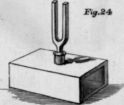Acoustics & Sound For Musicians - Online Book
The Theory Of Sound Which Constitutes The Physical Basis Of The Art Of Music.
| Share page | Visit Us On FB |
|
III. §§ 41, 42.] RESONANCE-BOXES. 81
fork's action traverses precisely one wave-length corresponding to the pitch of the note produced by the fork. Hence, for maximum resonance in the case of a stopped pipe, the wave-length corresponding to the note sounded must be four times as great as the length of the air-column, or the length of the column one quarter of the wave-length.
41. These principles give us the explanation of a useful appliance for intensifying the sound of a tuning-fork. Such a fork, when held in the hand after being struck, communicates but little of its vibrations to the surrounding air; when, however, its handle is screwed into one side of a wooden box of suitable dimensions, in the way shown in Fig. 24, the tone becomes much louder. The vibrations of the fork pass from its handle to the wood of the box, |
||
 |
||
|
and thence to the air-column within, which is of appropriate length for maximum resonance to the fork's note. This convenient adjunct to a tuning-fork goes by the name of a ' resonance-box.'
42. When a number of musical sounds are' t. 6 |
||